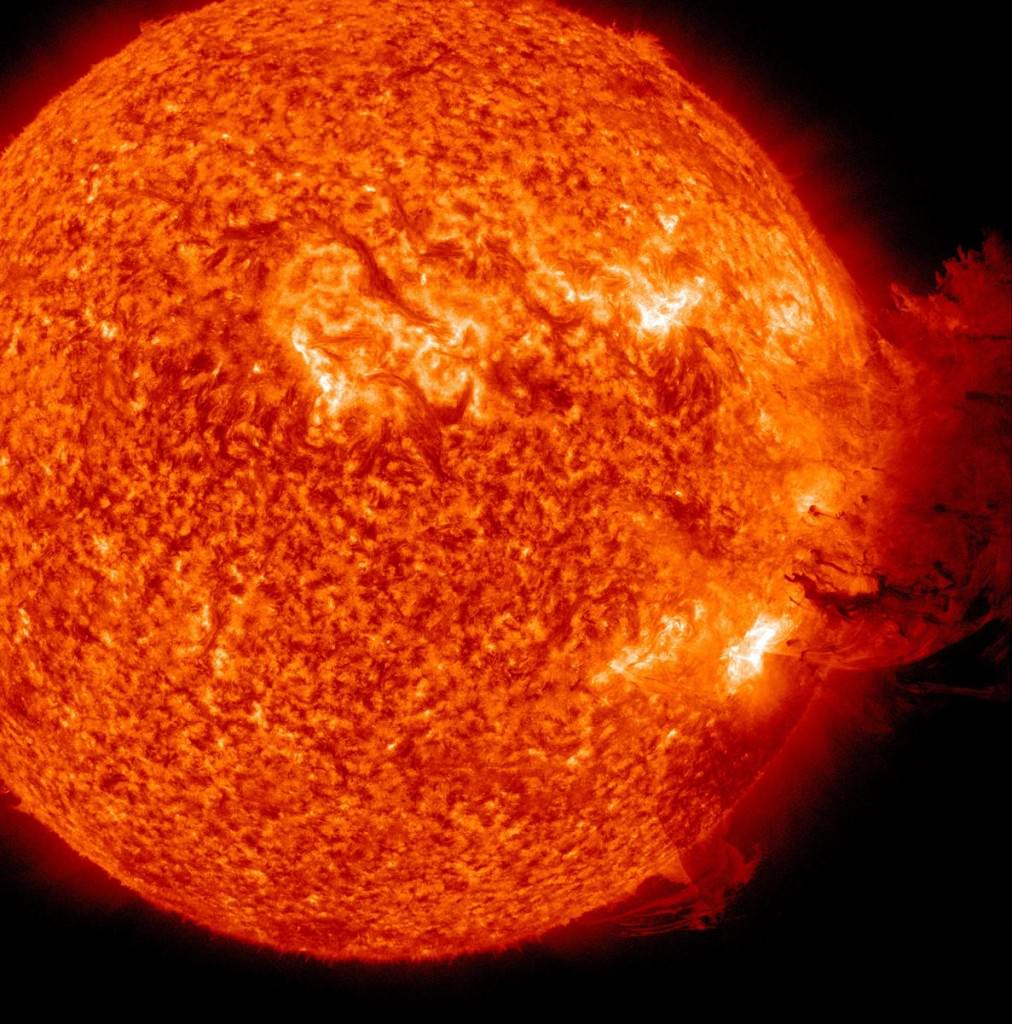Imagine a solar storm generating auroral displays across the entire sky. No, we haven’t quite seen them that strong in the current solar cycle. But, back in February 1872, people around the world reported seeing brilliant northern and southern lights.
The culprit? A medium-sized sunspot group that unleased a torrent of charged particles in a coronal mass ejection directed toward Earth. As with strong space weather storms today, the long-ago event not only sent aurorae dancing across most of Earth’s skies, but it disrupted technology. It affected telegraph communications on the submarine cable in the Indian Ocean between Bombay (Mumbai) and Aden for hours.
Similar disturbances were reported on the landline between Cairo and Khartoum. That presaged the damage that such storms can do to today’s power grids and satellite communications. Nowadays scientists know quite a bit more about the solar activity that causes these storms.
Back in those days, however, solar science was still in its infancy. We didn’t have globe-girdling, interconnected communications systems. And, then as now, extremely strong solar storms were relatively rare, but they could still do damage.
Today, we are well aware of the threat to modern technologies. Strong solar storms can shut down power stations, stop communications, threaten the world’s financial and trade systems, and harm life. “The longer the power supply could be cut off, the more society, especially those living in urban areas, will struggle to cope,” said Hisashi Hayakawa, the lead author of a group studying ancient solar storms.
“Could we maintain our life without such infrastructure? Well, let us just say that it would be extremely challenging. ” The 1872 solar event was named the Chapman-Silverman storm. Recently, an international team of 22 scientists, led by Hayakawa at Nagoya University in Japan, Edward Cliver at the US National Solar Observatory, and Frédéric Clette of the Royal Observatory of Belgium studied it in great detail.
Their tools were historical records coupled with modern techniques to assess the Chapman-Silverman storm from its origins on the Sun to its impact on our planet. How do you go about finding records for a storm that far back? First, you look at sunspot records. People have long sketched sunspot groups and records go back quite far.
The team scoured Belgian and Italian records of sunspots during the period. For terrestrial impacts, they used geomagnetic field measurements recorded in places as diverse as Bombay (Mumbai), Tiflis (Tbilisi), and Greenwich. Those gave them insight into the temporal evolution and intensity of the storm.
Finally, they examined hundreds of accounts of visual aurorae caused by the storm, written in different languages. “Our findings confirm the Chapman-Silverman storm in February 1872 as one of the most extreme geomagnetic storms in recent history. Its size rivaled those of the Carrington storm in September 1859 and the NY Railroad storm in May 1921,” Hayakawa said.
“This means that we now know that the world has seen at least three geomagnetic superstorms in the last two centuries. Space weather events that could cause such a major impact represent a risk that cannot be discounted. ” While very extreme solar storm events are rare, Hayakawa points out that there have been three superstorms like the 1872 event since the mid-19th century.
The famous Carrington Storm of September 1859 (also referred to as the Carrington Event) was the most intense geomagnetic storm in recorded history. It lasted for more than a day and created global auroral displays seen nearly all around the world. It, like the later Chapman-Silverman storm also affected telegraph lines.
Another very strong solar storm occurred in May 1921. Dubbed the New York Railroad Storm, it lasted for three days as the result of an extremely powerful coronal mass ejection from the Sun. Electrical currents stirred up in our atmosphere by the storm sparked several fires, including one close to New York’s Grand Central Terminal.
That’s how the storm got its railway-related name. As with other strong geomagnetic storms, this one came accompanied by brilliant auroral displays. It also affected telegraph service and long-distance radio signals.
Hayakawa suggested that our technology-heavy societies are quite lucky not to have experienced events like these. “We are fortunate to have missed such superstorms in the modern time,” he said. “On the other hand, the occurrence of three such superstorms in six decades shows that the threat to modern society is real.
Therefore, the preservation and analysis of historical records is important to assess, understand, and mitigate the impact of such events. ” Today, we’re currently in solar cycle 25, ramping up to solar maximum within the next year. Several outbursts from the Sun have lit up our skies in the past few months.
Those auroral displays showed up outside of the polar and northern/southern regions of the planet. And, as solar max nears, we can expect to see more activity from the Sun affecting Earth. Will we experience any extreme solar storms? There’s no way to know.
All it takes is one very strong solar outburst from a sunspot group (and it doesn’t have to be a big cluster) aimed in our direction. Luckily, we do have the capability to track these outbursts as soon as they leave the Sun. Scientists can give early warning about these solar storms so that satellite operators, grid owners, and other technology concerns can take action to avoid the worst damage.
One of the largest magnetic storms in history quantified: Aurorae covered much of the night sky from the Tropics to the Polar Regions The Extreme Space Weather Event of 1872 February: Sunspots, Magnetic Disturbance, and Auroral Displays.
From: universetoday
URL: https://www.universetoday.com/164668/in-1872-a-solar-storm-hit-the-earth-generating-auroras-from-the-tropics-to-the-poles/



